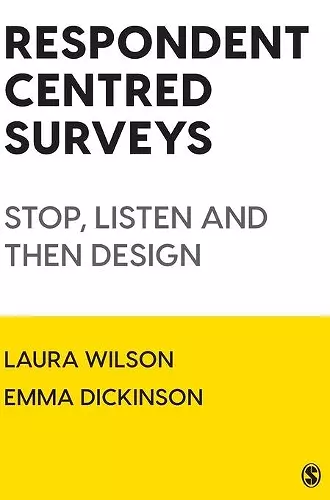Respondent Centred Surveys
Stop, Listen and then Design
Laura Wilson author Emma Dickinson author
Format:Paperback
Publisher:Sage Publications Ltd
Published:2nd Dec '21
Currently unavailable, and unfortunately no date known when it will be back
This paperback is available in another edition too:
- Hardback£182.00(9781529701272)

Achieve your survey goals by empowering your survey respondents.
Too often, surveys are designed for the analyst, rather than the respondent. This book challenges the status quo by putting respondents’ needs at the heart of survey development. It encourages you to stop, listen, and then design to improve response rates and collect high quality data.
Drawing on their experience at the UK Office for National Statistics, the authors:
- Show you how to design better surveys by combining social research and user experience best practice.
- Equip you with the tools to design inclusive and accessible surveys.
- Enable you to overcome practical research problems, including managing participant recruitment, and working to any budget.
- Provide links to helpful web material and further reading as part of the book′s online resources.
Promoting a new way to conceptualise and conduct survey design, this book expands your theoretical thinking and shows you, step-by-step, how to put it into practice.
"The beauty of the book is that it is highly practical and applicable across various settings. It starts by detailing the respondent-centred design principles and frameworks, but then moves quickly to explain how these can be applied in practice and even how to implement a respondent-centred approach with different levels of resources. The concrete examples from the Office for National Statistics bring the work to life.
It’s written in an engaging, practical and fresh way which makes it a pleasure to read. It encourages a deeper engagement with your work, and an understanding and appreciation of respondents’ mental models through testing. It is a must read for anyone designing respondent-facing tools and materials, whether working in academia, government or a research agency. This is particularly so in the face of falling response rates and as more and more research is moving online where interviewers are not present to help respondents navigate the survey concepts. It will transform your ways of thinking." -- Katriina Lepanjuuri
This book is an eagerly-awaited contribution on an important topic that has received little research attention. Given the voracious demands of data users for more – and more complex – survey data, the need for a respondent-centered perspective on design has become ever-more pressing. This book rightly puts a focus on the providers of survey data, whether directly (survey respondents) or indirectly (interviewers).
It makes a welcome addition to the survey design literature and provides valuable practical advice and guidance, not only for those working on large, complex surveys in national statistical institutes, but for anyone interested in improving surveys for those who give up their time to respond to them. I expect this book will be widely used by practitioners and researchers alike. -- Mick Couper
This book brings respondent-centred design front and center in survey design and administration, the philosophy being that the product (the survey instrument) should match the user (respondent), rather than the other way around. By bringing principles of user experience (UX) research into survey design, the authors turn the traditional process around, starting with respondents first, and providing concrete examples of the successes of this approach from the Office for National Statistics.
A book ahead of its time and a must-read for both survey and UX communities. -- Mario Callegaro
We are all facing declining response rates to our surveys, and our respondents increasingly expect that any worthwhile survey will conform to the best practices of the age of digital. This book introduces survey methodologists to ‘respondent-centred design’, firmly based on years of experience of improving the respondent experience of surveys at the UK Office of National Statistics. I particularly recommend Chapter 2, on principles, and the many detailed case studies that show how their approaches work. -- Caroline Jarrett
Surveys aren’t the quick and easy insight gathering tools people imagine them to be. It takes a lot of work to deliver a high quality survey from start to finish. This book will help you do just that: it’s a practical guide to creating surveys in a respondent-centred and agile way, meeting the needs of respondents and data users alike, by creating something that is understandable and relevant. This will help you, as survey creators, to do the hard work to make things simple. -- Stephanie Marsh
This is an important book and a must-have for anyone involved in designing or commissioning surveys. Packed with examples, it illustrates the value of adopting a respondent-centred design approach and how it can be applied. -- Debbie Collins
The book makes a powerful case for the involvement of members of the target population in the development of the survey, building bridges between survey methodology and user design to illustrate the value and role of user insights in the survey design process. -- Gerry Nicolaas and Debbie Collins
In bringing together modern design-thinking and traditional survey methodologies Laura and Emma have struck gold and landed on an approach that has the potential to influence survey design far beyond the National Statistical Institutes.
My time at the Office for National Statistics as Head of Digital Transformation cursed me with an understanding of what good survey design required but without the language to share that knowledge. This book provides a blueprint for anybody who, like me, has a vested interest in improving survey design wherever you might encounter it on the internet. -- Matt Jukes
ISBN: 9781529701265
Dimensions: unknown
Weight: 450g
248 pages